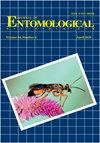Insecticidal Activity of Essential Oil from Seeds of Foeniculum vulgare (Apiales: Apiaceae) Against Sitophilus zeamais (Coleoptera: Curculionidae) and Its Effects on Crop Seed Germination
IF 0.7
4区 农林科学
Q4 ENTOMOLOGY
引用次数: 1
Abstract
Abstract Many aromatic herbs in the family Apiaceae produce essential oils that are used on an industrial scale for medicinal, cosmetic, and food purposes. Essential oils from plants that show insecticidal activity can be substituted for synthetic insecticides to reduce environmental pollution or harmful toxicity to humans. Insecticidal activity of essential oil from seeds of coriander, Foeniculum vulgare Miller (Apiales: Apiaceae), on maize weevil, Sitophilus zeamais Motschulsky (Coleoptera: Curculionidae), and its effects on seed germination of three major economic crops were investigated. Essential oil from F. vulgare seeds was analyzed by gas chromatography–mass spectrometry and found to contain 25 components, with anethole (43.78%) as the main constituent. Other basic compounds were estragole (28.33%), fenchone (16.68%), d-limonene (2.62%), alpha-pinene (1.84%), and p-cymene (1.28%). Foeniculum vulgare essential oil was toxic to maize weevil when used as a fumigant with a median lethal concentration at 48 h of 10.42 µL/L air. A concentration of 64 µL/L air was most effective, killing 100% of maize weevil within 24 h. The repellent effect on maize weevil increased to 75% at 24 h at a concentration of 16 µL/L air. Rice (Oryza sativa L.) and sorghum (Sorghum bicolor [L.] Moench) seeds fumigated with 32 µL/L air of F. vulgare essential oil exhibited a slight decrease in germination rate (germination >90%). Our results indicate that essential oil from F. vulgare seeds have potential for application in the management of maize weevil in stored products.小茴香种子精油对玉米象虫的杀虫活性及其对作物种子萌发的影响
摘要Apiaceae科中的许多芳香草本植物产生的精油在工业规模上用于医药、化妆品和食品目的。表现出杀虫活性的植物精油可以取代合成杀虫剂,以减少环境污染或对人类的有害毒性。研究了香菜种子茴香精油(Apiales:Apiaceae)对玉米象甲玉米象(Coleoptera:Curculionidae)的杀虫活性及其对三种主要经济作物种子发芽的影响。用气相色谱-质谱法分析了苦楝种子中的精油,发现其含有25种成分,其中以茴香脑(43.78%)为主要成分。其他碱性化合物为雌二醇(28.33%)、茴香醚(16.68%)、d-柠檬烯(2.62%)、α-蒎烯(1.84%)和对-cymene(1.28%)。茴香精油用作熏蒸剂时对玉米象甲有毒,48小时内的中位致死浓度为10.42µL/L空气。64µL/L的空气浓度最有效,在24小时内杀死100%的玉米象甲。在16µL/L空气浓度下,24小时对玉米象甲的排斥作用增加到75%。水稻(Oryza sativa L.)和高粱(sorghum bicolor[L.]Moench)种子用32µL/L的F.vulgare精油熏蒸后,发芽率略有下降(发芽率>90%)。我们的研究结果表明,从F.vulgare种子中提取的精油在管理储存产品中的玉米象甲方面具有应用潜力。
本文章由计算机程序翻译,如有差异,请以英文原文为准。
求助全文
约1分钟内获得全文
求助全文
来源期刊
CiteScore
1.20
自引率
11.10%
发文量
40
审稿时长
>12 weeks
期刊介绍:
The Journal of Entomological Science (ISSN 0749-8004) is a peer-reviewed, scholarly journal that is published quarterly (January, April, July, and October) under the auspices of the Georgia Entomological Society in concert with Allen Press (Lawrence, Kansas). Manuscripts deemed acceptable for publication in the Journal report original research with insects and related arthropods or literature reviews offering foundations to innovative directions in entomological research

 求助内容:
求助内容: 应助结果提醒方式:
应助结果提醒方式:


